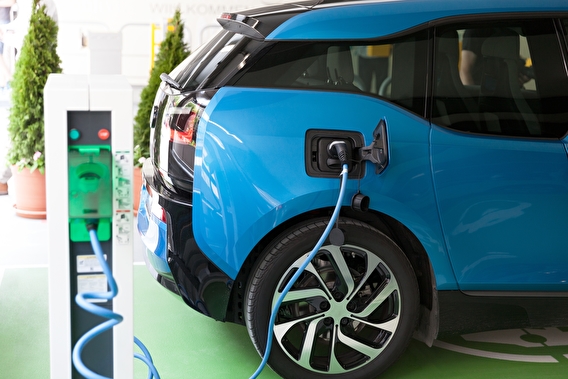
Electric vehicles (EVs) are expected to capture a substantial portion of the future vehicle market. In the short term, however, technology and infrastructure limitations—such as driving range and charging availability—will prevent transition on a large scale. Because EVs will share the road network with gasoline vehicles (GVs), says Alireza Khani, “it’s crucial to understand how EVs and GVs will coexist.”
Khani, an associate professor in the U’s Department of Civil, Environmental, and Geo- Engineering (CEGE), and CEGE graduate student Behnam Davazdah Emami developed a model that can analyze the effect of EVs on transportation systems. It can be used for evaluating transportation policies such as EV purchase subsidy, EV charging cost, and at-home vs. public charging availability.
When choosing routes, EV drivers need to consider not just distance and travel time but also battery range and charger availability. “This distinction undoubtedly affects transportation network performance,” Khani says.
In their study, the researchers developed a mixed-user equilibrium model for networks with EVs and GVs. In the model, the demand for each vehicle class depends on route characteristics and the availability of electric charging stations on those routes. The model also incorporates the effect of ownership and operating costs on the demand for each class under different EV subsidy policies. In addition, it accounts for the charging behavior of EV users in urban areas.
“We included the types of charging stations because we believe some users might prefer public charging stations to home-based ones when the cost of charging in home-based stations is more expensive than charging in public ones,” Khani explains.
They applied the model to networks in Sioux Falls, SD, and Chicago. Among the patterns found on the Chicago network:
- Providing incentives for EV purchase—such as an initial cost subsidy, rebate, or credit—leads to a significant increase in the EV penetration rate. For example, a 10 percent reduction in the purchase cost of EVs could lead to 6 percent more commuters choosing EVs.
- More incentives and higher EV penetration increase vehicle-miles traveled (VMT) for EVs and decrease VMT for gasoline vehicles. The total VMT in the network (EVs + GVs) would likely increase.
- By reducing per-mile costs, government spending for EV incentives reduces total travel costs in the transportation network. Spending would break even with—or potentially be slightly less than—the network cost savings.
- Considering the travel range of EVs, commuters whose trip length is just slightly shorter than EV range could receive the highest benefit from EVs and have a higher likelihood of adopting EVs.
- Commuters who place a higher value on their time are less likely to use public charging stations.
The paper—“Nonlinear Complementarity Model for Mixed-User Equilibrium Traffic Assignment and Mode Choice of Electric and Gasoline Vehicles”—was published in the Transportation Research Record, 2023.
The research was conducted at the U of M Transit Lab, currently supported by, but not limited to, the following sponsors: National Science Foundation; Freight Mobility Research Institute, USDOT; Minnesota Department of Transportation; Metropolitan Council; and Hennepin County.
Writer: Pam Snopl


